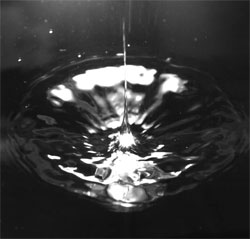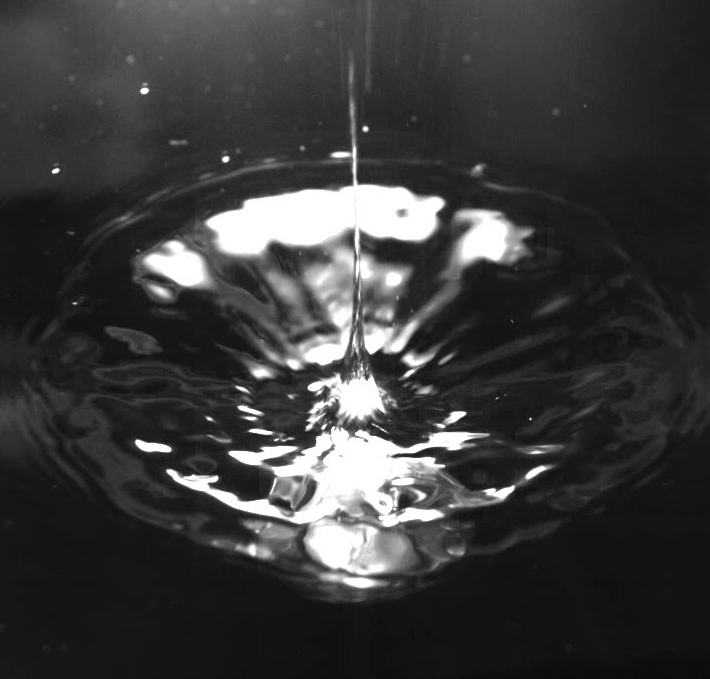Why Dropping a Stone Makes a Jet
The splash of a solid object into water–be it a coin or an Olympic high diver–is capped off by a thin jet of fluid shooting straight up from the surface. The detailed explanation of this seemingly simple event has proved elusive. Now researchers publishing in the 23 January Physical Review Letters think they have a more complete explanation than their predecessors. Using a combination of theory, simulation, and experiment, they studied the collapse of the air cavity trailing the submerged object, concluding that it ejects water like toothpaste squeezed rapidly from its tube.
A solid object plows a roughly symmetrical tube of air into a fluid. The sideways pressure exerted by the surrounding water quickly begins to collapse the cavity, first by pinching off the cylinder at its midpoint. Twin jets shoot straight up and down from the pinch-off point, called a pinch singularity. Researchers had assumed that the concentrated forces built up at the pinch point were sufficient to drive jet formation, says Stephan Gekle, a graduate student at the University of Twente in the Netherlands. In some models, the build-up comes from a mix of so-called inertial focusing–the concentration of energy as the cavity collapses–and surface tension violently drawing the cavity shut.
But nobody had proved that the jet was a direct outgrowth of the pinch alone, says Gekle. “You still have the wall of the cavity,” he says. “You have to consider the entire cavity collapse.” So Gekle, his graduate supervisor Detlef Lohse, and their colleagues–including a collaborator from the University of Seville in Spain–expanded the inertial focusing analysis to cover the whole cylinder, which closes from the pinch-off point as if zippers were being pulled up and down. Inertial focusing occurs because water accelerates as it rushes in to fill the cylindrical cavity. As the water begins to fill in, the circumference of the cylinder shrinks, but the total volume of water coming in per unit time remains constant. With less space to move through, the water must speed up. (This same principle explains why pinching a garden hose increases the stream’s speed.) Finally, hemmed in all around, the water has nowhere to go but up or down.
The team pulled a 4-centimeter-diameter circular disk down through a water surface at 1 meter per second and used high-speed imaging to track the base of the jet as it moved up from the pinch-off point. Then they simulated the jet base on a computer. The simulated and real motion agreed closely, although the simulated jet base ascended faster than the real one, a discrepancy Gekle blames on the slight asymmetry of the real thing. The formation of the jet was the same whether or not they included surface tension in the simulation, indicating that whatever role it may play prior to pinch-off, surface tension was not driving the jet by flinging water up like a trampoline tossing an acrobat, as some had speculated.
The simulation in turn agreed with a mathematical treatment, which together gave the team new insight into the jet-generation mechanism. “Our new mechanism says that the exact driving of the pinch-off … is not the most important factor in the game,” Gekle says. Instead, the group found that as the jet base moves upward, the continued inertial focusing draws in more water and accelerates it upward, much like squeezing a toothpaste tube quickly from bottom to top. Gekle says a single push from the pinch-off point–like a single squeeze of the toothpaste tube–would not provide enough force to maintain the jet.
The study lends “very convincing” support to the inertial origin of jetting, says Sigurdur Thoroddsen of King Abdullah University of Science and Technology in Jeddah, Saudi Arabia, who has studied high-speed water jets experimentally. “The fact that it combines theory, experiments, and numerical simulation gives it extra oomph,” he says. He adds that researchers will learn more when high-speed video cameras become powerful enough to resolve the instant when the momentum of the rushing water switches from inward to up and down. “I believe there are still some surprises awaiting in this jetting geometry.”
–JR Minkel
JR Minkel is a freelance science writer in New York City.





